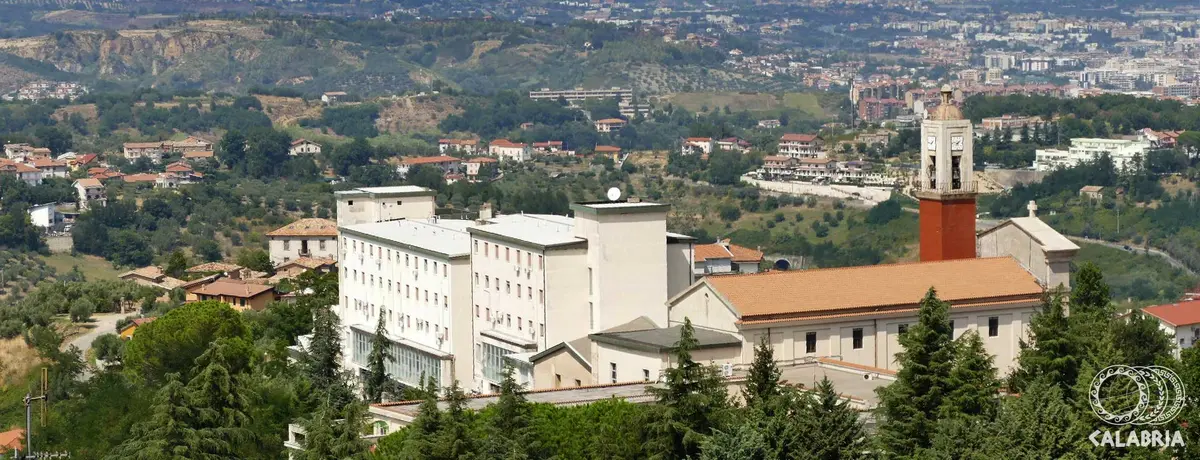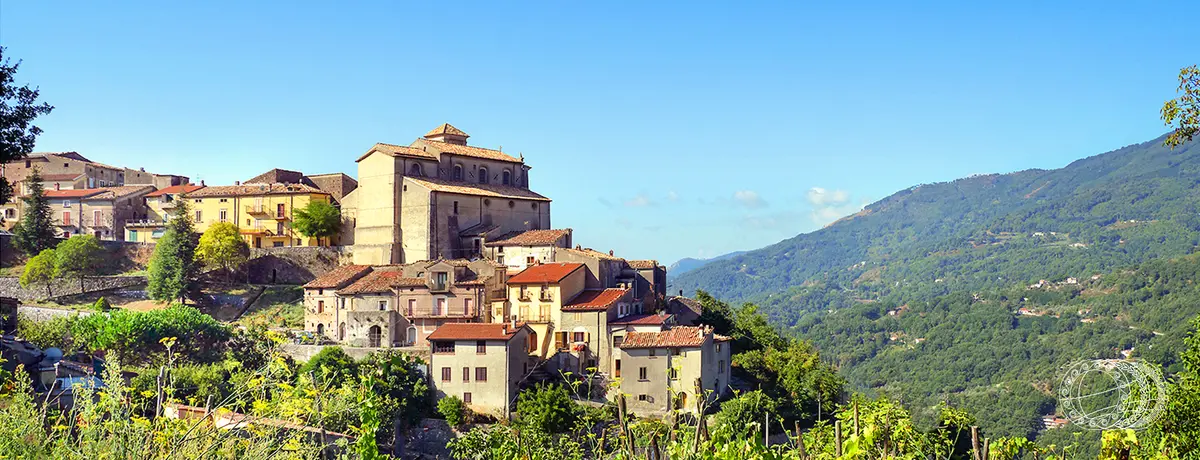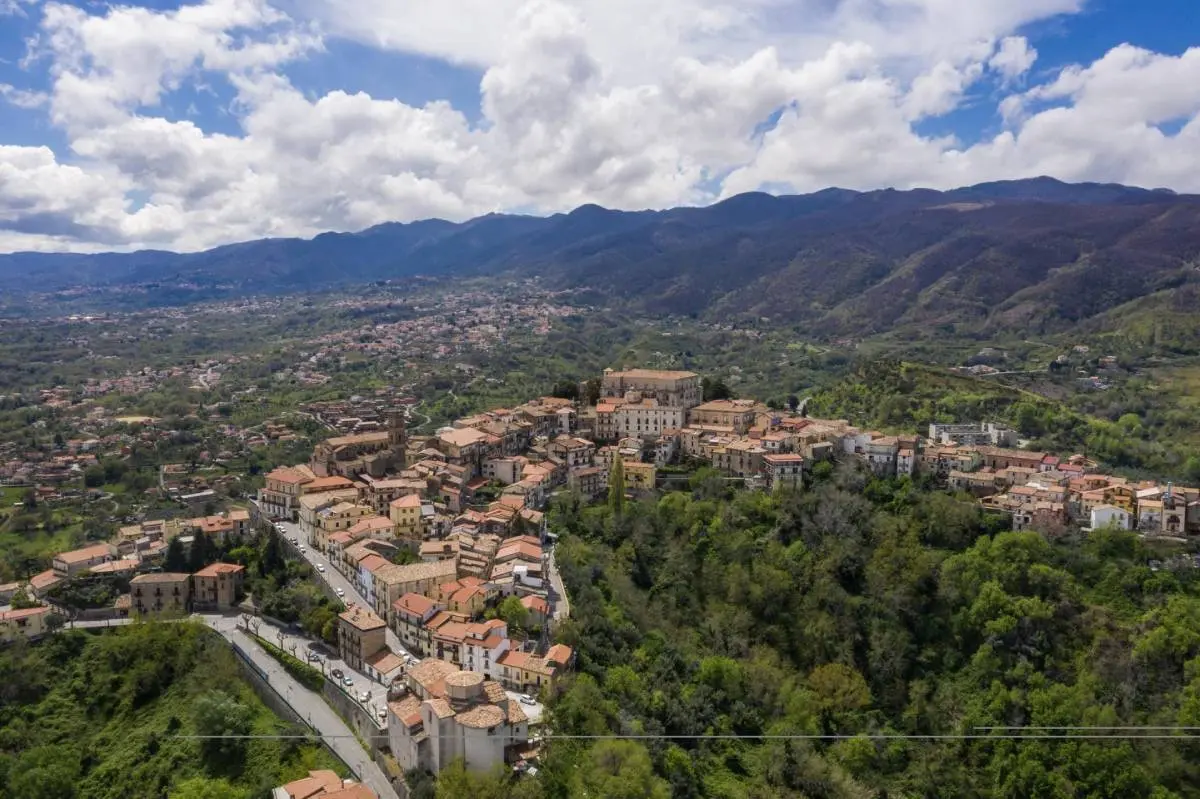Dipignano
Dipignano, the village of ancient trades

Town
Dipignano lies on a slope on the right side of the Iassa stream, in the Northern Crati Valley area, along the hilly ridge of the coastal Apennines chain. The area as a whole is characterised by varied and irregular features; rough cliffs and hollows, rock overhangs and deep gullies and panoramic viewpoints uninterruptedly alternate and make the landscape interesting and discontinuous, an ever-changing show as seasons go by.
During the course of the seasons these features offer to the visitor's eye a spectacle of rare beauty and charm. Dipignano’s old town centre constitutes a destination of great historical and artistic interest.
Dipignano owes much of its fame to handicrafts and the presence of master coppersmiths who reached levels of excellence.
In the Parrera area were the forgitelle; species of rudimentary outdoor stoves, where craftsmen carried out the work of cleaning and tinning of tableware for domestic use, while the forge was an entirely different thing, with some forges almost acting as foundries. In addition, there were also several small shops of metal workers and blacksmiths, as evidenced by some examples of railings for balconies, of fine workmanship, made by local artisans who still today adorn antique elegant buildings. There are several churches located within the area of Dipignano. Within the Reforma district is the Franciscan convent dedicated to the cult of the S.S. Ecce Homo with an adjoining shrine, also known as the Chiesa della Madonna delle Grazie (Church of Our Lady of Gratitude), and that represents significant evidence of the fifteenth-century sacred architecture. The convent was probably built around 1400 by the Friars Minor. A few years ago, substantial restoration works brought to light the original Gothic-Franciscan lines.
The church of the Ecce Homo is of Gothic-Romanesque style and its origins date back to 1500; it boasts a magnificent façade with an arcade in sandstone (tuff or locally known as “tufo”) and an imposing bell tower. Inside the church visitors can admire numerous paintings of exquisite workmanship, such as an oil on wood portraying the Madonna del Rosario con San Domenico e Santa Caterina (Madonna of the Rosary with St Dominic and St Catherine) attributed to Dirck Hendricksz and an oil on canvas of 1718 depicting the Immaculate. Particularly valuable is a statue of the Madonna delle Grazie, modelled by an artist of the Gagini school in 1578. Not to be missed is a remarkable seventeenth century wooden statue of Ecce Homo, attributed to friar Umile from Pietralia, but likely the work of friar Angelo from Pietrafitta, which in addition to its undisputed artistic value, is considered to produce miracles. Under the shrine’s presbytery it is possible to see a sepulchral area with funeral niches dug in the rock, where currently a modest museum has been established that conserves furnishings and sacred objects, in addition to a bell of 1680. The Santuario della Madonna della Catena was built as a Minor Basilica in 1966 by Pope Paul VI and is a place of pilgrimage and vocation, entrusted to the care and assistance of the order of the Passionist priests since 1906. The church, adorned with abundant marble and frescoes, contains the image of the Madonna della Catena crowned with the Vatican Chapter in 1921. The interior boasts many frescoes of Lucillo Grassi, who worked there for three years, from 1942 to 1945. Among these are: the Allegory of Faith, the Allegory of Charity, the Allegory of Hope, St Thomas Aquinas, St Gemma, St Paul of the Cross, the Sacred Family, St Michael Archangel, St Gabriel of Our Lady of Sorrows, Crucifixion, St Francis of Paola passing through the Strait of Messina, the great devotees of Our Lady, the Redemption.
Numerous are the oil paintings on canvas and there is also a wooden statue of the Madonna della Catena modelled in 1954 by Perathoner, a crucifix in papier-mâché from 1941 by the artist Manso, a wooden statue of the Immaculate, a wooden statue of the XV century depicting the Madonna and Child and 14 panels in bronze with the stations of the Cross by Galeotti of XX century.
Next to the church there is a large structure which in addition to accommodating the Passionists, welcomes large numbers of groups that stop for retreats and spiritual exercises. The “giardini verdi,” (green gardens), the library that contains over 36,000 volumes, the stations of the cross and the adjacent hospital facilities, surround a sacred setting.
The worship of the Madonna della Catena
According to the scholar Rocco Liberti, the worship of the Madonna della Catena has very remote origins to Laurignano of Dipignano, between 896 and the 1014, the period during which the city of Cosenza and neighbouring towns were devastated by Saracen raids. The worship was expressed in the painting of a slave shackled at the feet of the Virgin, begging for the dissolution of the chains, symbol of the scourge of slavery that struck both Christians and Muslims. The worship of the Madonna strengthened during periods of foreign invasions, only for interest to decline during periods of relative peace, especially for coastal towns that were increasingly exposed to the dangers of invasions. On the contrary, Laurignano, where miracles and visions were recorded, always retained a deep devotion to the Virgin Mary. It must be noted that in Laurignano the bond with the Saracen persecution no longer appears, as the current image shows a chain between the hands of Our Lady and hence not a slave at her feet, as instead was painted in the traditional common image.
The meaning of the symbol of the chain to the shrine was further enriched: the chain that Our Lady holds tight between the hands is seen not only as a symbol of dissolution and deliverance from evil, but also in the positive sense, of union with Jesus.
I "quadarari"
Dipignano owes much of its fame to the craftsmanship of copper, carried out by master coppersmiths since 1300. The Quadarari or Varbottari were wanderers, free spirits, more out of need than due to their nature, who spent a good part of the year away from their homes and loved ones. During their long pilgrimage, in 1650 came to Ponti in the province of Alessandria, where they requested political asylum and were greeted with warmth by the inhabitants and by the feudal lord the Marquis Del Carretto. In exchange, the quadarari built a huge copper pot served for the first colossal Polentone. To remember and to strengthen the bonds of the ancient friendship, by means of a solemn ceremony that took place in May 1965, the town of Dipignano became twinned with the town of Ponti.
Gastronomy
The tradition of good food is highly developed in this town where the art of baking home-made bread prevails; in fact, Dipignano’s ovens are well-known for baking the classic sponge cake known as “Tessano” (where all the ingredients are kneaded through) and Laurignano, that exports bread in Cosenza and to surrounding towns. The olive groves and some sporadic vineyard characterise the restricted areas intended for the cultivation and production of olive oil and wine. Above 700 metres prevail chestnut trees and chestnuts are actually one of the local greatest treasures. Dipignano’s typical cuisine is very rich in starters, main dishes and desserts.
Useful information
What to know about Dipignano
Infopoint Dipignano
Via XXIV Maggio, Dipignano
No result








